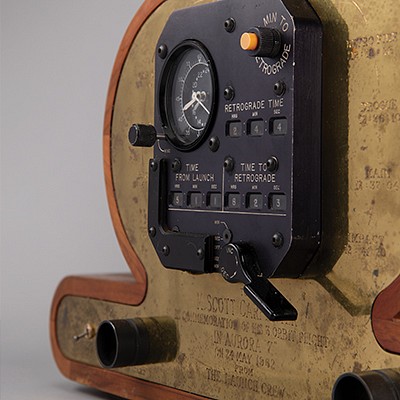STS-118 Space Shuttle Power Transfer Unit
Two ways to bid:
- Leave a max absentee bid and the platform will bid on your behalf up to your maximum bid during the live auction.
- Bid live during the auction and your bids will be submitted real-time to the auctioneer.
Bid Increments
| Price | Bid Increment |
|---|---|
| $0 | $5 |
| $50 | $10 |
| $200 | $25 |
| $500 | $50 |
About Auction
Oct 19, 2023
RR Auction support@rrauction.com
- Lot Description
An unflown Space Shuttle Power Transfer Unit (PTU) manufactured by Pratt & Whitney Rocketdyne for the STS-118 mission, which featured the first flight of the new Station‐to‐Shuttle Power Transfer System (SSPTS), a series of electrical converter units designed to provide additional power to the Space Shuttle while docked with the ISS, consequently allowing it to extend its missions and perform more complex tasks. The PTU, which measures 20″ x 7.5″ x 20″ and weighs 70 lbs, features a series of eight ports to the front and a Pratt & Whitney Rocketdyne label to the top: “Part Name: Power Transfer Unit - PTU, Part Number: MC409-0547-0010, Cage: 20602, Mfr. Part No.: R108230A1, Contract No.: 5H06865, Mfr. Name: Pratt & Whitney Rocketdyne Inc., Mfr. Serial No.: 9005091, Mfr’s Cage: 02602.” Also present to the top is a bar code label with parts information and an “XV” ITAR number, and a North American stamp that reads: “S/N 9003160, 02602-R108242-1, MFR 48458.” The right side bears a similar stamp: “S/N 9003149, 02602-R108233A2, MFR 48458.” In fine condition. Accompanied by its heavy-duty transportation case by Hardigg Cases / A&J Cases, with several affixed NASA “Critical Space Item” labels and a “U.S. Government Property, The Boeing Company” label. The case, 36″ x 30.5″ x 35″, also bears a KSC Form serviceable parts tag, a Pratt & Whitney Rocketdyne parts label, an uncontrolled hardware label, and a “Super Clean Pack” label, all of which feature numbers that match with the PTU.
The STS-118 mission featured the first flight of the new Station‐to‐Shuttle Power Transfer System (SSPTS), a series of electrical converter units in the shuttle that drew electricity from the ISS’s power system to supplement the normal electrical output from the shuttle’s three cryogenic fuel cells. The new capability is designed to extend the shuttle’s stay at the station to up to 12 days, if necessary, without depleting the finite electrical capability of the fuel cells themselves, thereby increasing the crew time available for scientific experiments, extravehicular activities, and remaining International Space Station assembly tasks. The SSPTS consisted of two Power Transfer Units (PTUs) in the shuttle, containing three converters per unit, two Orbiter Power Conversion Units (OPCUs), and one Assembly Power Conversion Unit (APCU). The STS-118 mission itself was significant for various reasons, including delivering and installing the S5 truss segment to the ISS, which extended the station's structural framework and provided additional support for solar arrays and other systems. The ability to draw power from the ISS through the SSPTS contributed to the success of the mission by allowing the Shuttle to perform these tasks and accomplish more objectives during its stay at the space station. - Shipping Info
-
Bidder is liable for shipping and handling and providing accurate information as to shipping or delivery locations and arranging for such. RR Auction is unable to combine purchases from other auctions or affiliates into one package for shipping purposes. Lots won will be shipped in a commercially reasonable time after payment in good funds for the merchandise and the shipping fees are received or credit extended, except when third-party shipment occurs. Bidder agrees that service and handling charges related to shipping items which are not pre-paid may be charged to a credit card on file with RR Auction. Successful international Bidders shall provide written shipping instructions, including specified Customs declarations, to RR Auction for any lots to be delivered outside of the United States. NOTE: Declaration value shall be the item’(s) hammer price and RR Auction shall use the correct harmonized code for the lot. Domestic Bidders on lots designated for third-party shipment must designate the common carrier, accept risk of loss, and prepay shipping costs.
-
- Buyer's Premium



 EUR
EUR CAD
CAD AUD
AUD GBP
GBP MXN
MXN HKD
HKD CNY
CNY MYR
MYR SEK
SEK SGD
SGD CHF
CHF THB
THB



















